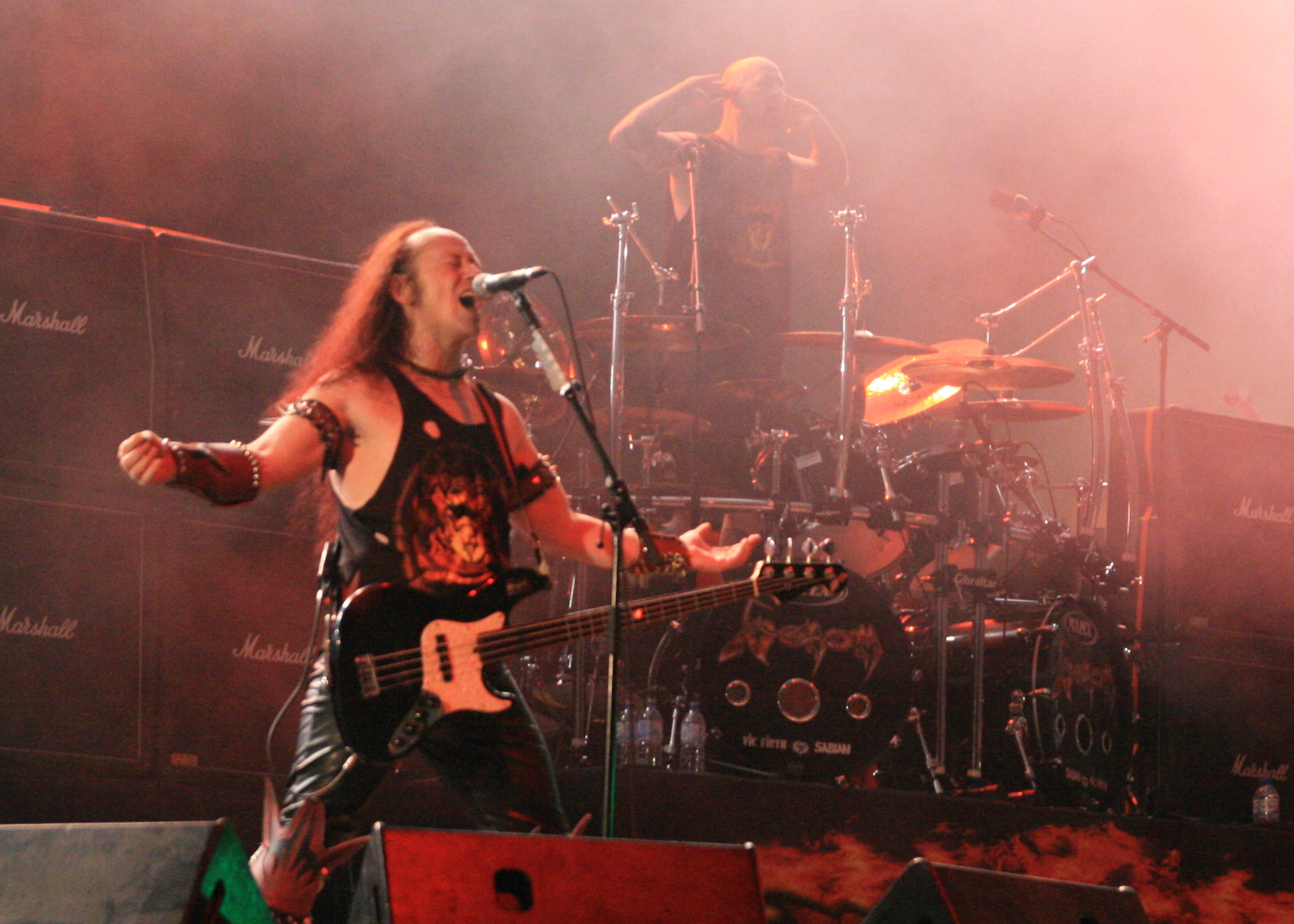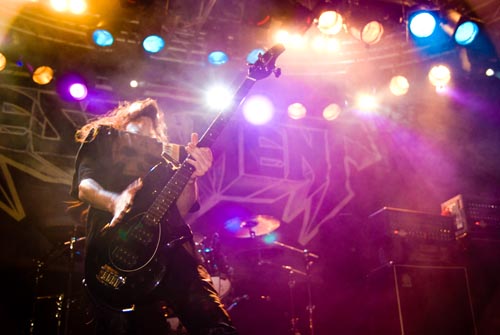|
Thrash Metal
Thrash metal (or simply thrash) is an Extreme metal, extreme subgenre of heavy metal music characterized by its overall aggression and fast tempo.Kahn-Harris, Keith, ''Extreme Metal: Music and Culture on the Edge'', pp. 2–3, 9. Oxford: Berg, 2007, . The songs usually use fast percussive beats and low-register guitar riffs, overlaid with Shred guitar, shredding-style lead guitar work. The genre emerged in the early 1980s as musicians began fusing the double bass drumming and complex guitar stylings of the new wave of British heavy metal (NWOBHM) with the speed and aggression of hardcore punk and the technicality of progressive rock. Philosophically, thrash metal developed as a backlash against both the conservatism of the Reagan era and the much more moderate, Pop music, pop-influenced, and widely accessible heavy metal subgenre of glam metal which also developed concurrently in the 1980s. Derived genres include crossover thrash, a fusion of thrash metal and hardcore punk. Th ... [...More Info...] [...Related Items...] OR: [Wikipedia] [Google] [Baidu] |
Brazilian Thrash Metal
Brazilian thrash metal is a musical movement that originated in the 1980s. Though not as large or well known as the North American or European thrash metal movements, it bridged the gap of the mid-1980s and the death metal scene later in the decade and the Black metal#First wave, first-wave of black metal. This genre is both raw and intense, drawing in global audiences and holding a legacy that inspires bands outside of the country. Brazilian thrash metal grew from a blend of thrash, progressive, and death metal influences around the world, expressing resistance, opposition, and rage. In a country experiencing political and social hardships, Brazilian metal became a way to express frustrations of young individuals longing for change in the system. The lack of resources led bands to self-release their music, rather than turning to a label. This style of thrash metal includes fast-paced rhythms and vocals that encapsulate the feelings of Brazil's people. Although some bands, like Se ... [...More Info...] [...Related Items...] OR: [Wikipedia] [Google] [Baidu] |
New Wave Of British Heavy Metal
The new wave of British heavy metal (often abbreviated as NWOBHM) was a nationwide musical movement that began in England in the mid-1970s and achieved international attention by the early 1980s. Editor Alan Lewis (music journalist), Alan Lewis coined the term for an article by Geoff Barton in a May 1979 issue of the British music newspaper ''Sounds (magazine), Sounds'' to describe the emergence of heavy metal music, heavy metal bands in the mid-to-late 1970s, as punk rock declined amid the dominance of new wave music. Although encompassing diverse styles inherited from rock music, the music of the NWOBHM is best remembered for infusing earlier heavy metal with the intensity of punk rock to produce fast and aggressive songs. The DIY ethic, DIY attitude of the NWOBHM bands led to raw-sounding, self-produced recordings and a proliferation of independent record labels. Song lyrics were usually about escapism, escapist themes, such as mythology, fantasy, horror, and the rock 'n' r ... [...More Info...] [...Related Items...] OR: [Wikipedia] [Google] [Baidu] |
Teutonic Thrash Metal
Teutonic thrash metal is a regional scene of thrash metal music that originated within German-speaking countries during the 1980s, and its title is a reference to the Germanic tribe. Along with Bay Area thrash metal, East Coast thrash metal, and Brazilian thrash metal, this was one of the major scenes of thrash metal in the 1980s, and it was developed and popularized by four German bands – Destruction, Kreator, Sodom and Tankard – that have been referred to as "The Big Four of Teutonic Thrash". The label of "Big Four" has often been rejected, emerging from the belief that the influence and popularity of Tankard was far less than that of the other 3, leading to the alternate title, "the Teutonic Trio".D, Hoffman. (Director) Total Thrash - The Teutonic Story ilmMindjazz Pictures History Two bands influential to early Teutonic thrash metal were Destruction (from Lörrach) and Holy Moses (from Aachen). After hearing Venom, both bands soon changed their sound within a matte ... [...More Info...] [...Related Items...] OR: [Wikipedia] [Google] [Baidu] |
New Wave Of British Heavy Metal
The new wave of British heavy metal (often abbreviated as NWOBHM) was a nationwide musical movement that began in England in the mid-1970s and achieved international attention by the early 1980s. Editor Alan Lewis (music journalist), Alan Lewis coined the term for an article by Geoff Barton in a May 1979 issue of the British music newspaper ''Sounds (magazine), Sounds'' to describe the emergence of heavy metal music, heavy metal bands in the mid-to-late 1970s, as punk rock declined amid the dominance of new wave music. Although encompassing diverse styles inherited from rock music, the music of the NWOBHM is best remembered for infusing earlier heavy metal with the intensity of punk rock to produce fast and aggressive songs. The DIY ethic, DIY attitude of the NWOBHM bands led to raw-sounding, self-produced recordings and a proliferation of independent record labels. Song lyrics were usually about escapism, escapist themes, such as mythology, fantasy, horror, and the rock 'n' r ... [...More Info...] [...Related Items...] OR: [Wikipedia] [Google] [Baidu] |
Shred Guitar
Shred guitar is a virtuosic style of electric guitar performance. Categorized by its use of advanced techniques, shredding is a complex art form. Shred guitar includes fast alternate picking, sweep-picking, diminished and harmonic minor scales, tapping, and whammy bar use. Often incorporated in heavy metal, guitarists employ a guitar amplifier and a range of effects such as distortion. This creates a sustained guitar tone and may facilitate guitar feedback. The term is sometimes used in reference to virtuosic playing by instrumentalists other than guitarists as well. The term "shred" is used outside the metal idiom, particularly by bluegrass musicians and jazz-rock fusion electric guitarists. History Many jazz guitarists in the 1950s such as Les Paul, Barney Kessel and Tal Farlow used an improvised technique by raking the pick across the strings to play a rapid succession of notes, today known as sweep picking. Les Paul's performance of " How High the Moon" contained s ... [...More Info...] [...Related Items...] OR: [Wikipedia] [Google] [Baidu] |
Riffs
A riff is a short, repeated motif or figure in the melody or accompaniment of a musical composition. Riffs are most often found in rock music, punk, heavy metal music, Latin, funk, and jazz, although classical music is also sometimes based on a riff, as in Ravel's Boléro. Riffs can be as simple as a tenor saxophone honking a simple, catchy rhythmic figure, or as complex as the riff-based variations in the head arrangements played by the Count Basie Orchestra. David Brackett (1999) defines riffs as "short melodic phrases", while Richard Middleton (1999) defines them as "short rhythmic, melodic, or harmonic figures repeated to form a structural framework". Author Rikky Rooksby states: "A riff is a short, repeated, memorable musical phrase, often pitched low on the guitar, which focuses much of the energy and excitement of a rock song." BBC Radio 2, in compiling its list of 100 Greatest Guitar Riffs, defined a riff as the "main hook of a song", often beginning the song, and i ... [...More Info...] [...Related Items...] OR: [Wikipedia] [Google] [Baidu] |
Heavy Metal Music
Heavy metal (or simply metal) is a Music genre, genre of rock music that developed in the late 1960s and early 1970s, largely in the United Kingdom and United States. With roots in blues rock, psychedelic rock and acid rock, heavy metal bands developed a thick, monumental sound characterized by distortion (music), distorted guitars, extended guitar solos, emphatic Beat (music), beats and loudness. In 1968, three of the genre's most famous pioneers – British bands Led Zeppelin, Black Sabbath and Deep Purple – were founded. Though they came to attract wide audiences, they were often derided by critics. Several American bands modified heavy metal into more accessible forms during the 1970s: the raw, sleazy sound and shock rock of Alice Cooper and Kiss (band), Kiss; the blues-rooted rock of Aerosmith; and the flashy guitar leads and party rock of Van Halen. During the mid-1970s, Judas Priest helped spur the genre's evolution by discarding much of its blues influence,Walser (1 ... [...More Info...] [...Related Items...] OR: [Wikipedia] [Google] [Baidu] |
Thrasher (magazine)
Thrasher is an American skateboarding media brand founded in January 1981 by Eric Swenson and Fausto Vitello, who also founded Independent Truck Company, and officially launched as a skateboard magazine. Since the 1990s, Thrasher has expanded its presence in television, video production, online blogging and merchandising. History ''Thrasher'' was founded in 1981 by Fausto Vitello and Eric Swenson, primarily as a way to promote Independent Truck Company, their skateboard truck company. The magazine's first editor was Kevin Thatcher. Photographer/graphic designer/illustrator/journalist/Assistant Publisher/General Manager, Mörizen Föche - aka Mofo, became the second staff member, joining Thatcher in mid-1981. In 2016, ''Mofo'' was inducted into the Skateboarding Hall of Fame. In 1989, Cara-Beth Burnside became the first woman to appear on the cover of ''Thrasher''. In 1993, Jake Phelps was named editor of the magazine, bringing the punk-skater ethic to the world th ... [...More Info...] [...Related Items...] OR: [Wikipedia] [Google] [Baidu] |
Thrashcore
Thrashcore (also known as fastcore) is a fast-tempo subgenre of hardcore punk that emerged in the early 1980s. Thrashcore is essentially sped-up hardcore, adopting a slightly more extreme style by means of its vocals, dissonance, and occasional use of blast beats. Songs are usually very brief, and thrashcore is in many ways a less dissonant, minimally metallic forerunner of grindcore. The genre is sometimes associated with the skateboarder subculture. Terminological ambiguity Thrashcore is often confused with crossover thrash and sometimes thrash metal.Felix von Havoc''Maximum Rock'n'Roll'' #198. Retrieved June 20, 2008."Powerviolence: The Dysfunctional Family of Bllleeeeaaauuurrrgghhh!!". ''Terrorizer'' no. 172. July 2008. p. 36-37. Further confusion is added by the fact that many crossover bands, such as D.R.I., began as influential thrashcore bands. Throughout the '80s, the term "thrash" was in use as a synonym for hardcore punk (as in the '' New York Thrash'' compilation ... [...More Info...] [...Related Items...] OR: [Wikipedia] [Google] [Baidu] |
New Wave Of American Heavy Metal
The new wave of American heavy metal (also known as NWOAHM and new wave of American metal) was a heavy metal music movement that originated in the United States during the early–mid 1990s and expanded most in the early to mid-2000s. Some of the bands considered part of the movement had formed as early as the late 1980s, but did not become influential or reach popular standing until the following decade. The term itself borrows from the new wave of British heavy metal dating to 1979. NWOAHM includes a wide variety of styles, including alternative metal, groove metal, industrial metal, nu metal and metalcore. The term was reportedly coined by Mark Hunter, vocalist of the American metalcore band Chimaira, in 2001. Although the term is used by the media with increasing frequency, the definition has not been finished completely. This is due in part to the growing addition of bands that assimilate to common styles in NWOAHM (as defined below), yet have not differentiated greatly eno ... [...More Info...] [...Related Items...] OR: [Wikipedia] [Google] [Baidu] |
Extreme Metal
Extreme metal is a loosely defined umbrella term for a number of related heavy metal music subgenres that have developed since the early 1980s. It has been defined as a "cluster of metal subgenres characterized by sonic, verbal, and visual transgression". The term usually refers to a more abrasive, harsher, underground, non-commercialized style associated with the speed metal, thrash metal, black metal, death metal, and doom metal genres.K. Kahn-Harris, ''Extreme Metal: Music and Culture on the Edge'' (Berg Publishers, 2007), , p. 31. Hardcore punk has been considered an integral part of the development of extreme metal in song structure and speed, apart from the case of doom metal. Definitions Extreme metal acts set themselves apart from traditional heavy metal acts, such as Iron Maiden, Judas Priest and Motörhead, by incorporating more abrasive musical characteristics such as higher tempos, increased aggression and a harsher extremity. In the majority of the world ... [...More Info...] [...Related Items...] OR: [Wikipedia] [Google] [Baidu] |
Bay Area Thrash Metal
Bay Area thrash metal (also known as Bay Area thrash) referred to a steady following of heavy metal bands in the 1980s who formed and gained international status in the San Francisco Bay Area in California. Along with Central Florida, the scene was widely regarded as a starting point of American thrash metal, crossover thrash and death metal. History Exodus and Metallica The earliest documented roots of the Bay Area thrash scene date back to the formation of Exodus in 1979. By the time the group recorded their full-length album four years later, five different guitarists or bassists had already passed through the lineup, with some going on to join or form bands that were equally relevant to the area's burgeoning metal scene. In November 1982, Exodus opened a show at San Francisco's Old Waldorf venue for Metallica, a then-relatively unknown (and unsigned) band from Southern California who were recently discovered by Brian Slagel and had appeared on the first volume of his ... [...More Info...] [...Related Items...] OR: [Wikipedia] [Google] [Baidu] |








